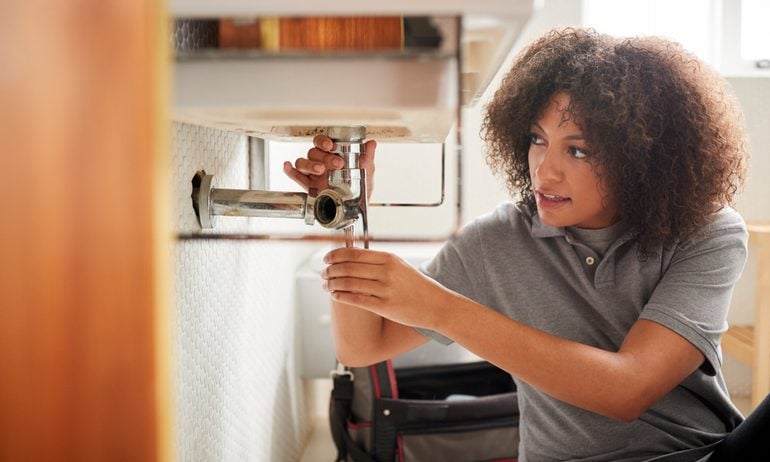Does Homeowners Insurance Cover Mold?
Most home insurance policies pay for mold only if it’s the result of a sudden, accidental event your policy covers.

Many, or all, of the products featured on this page are from our advertising partners who compensate us when you take certain actions on our website or click to take an action on their website. However, this does not influence our evaluations. Our opinions are our own. Here is a list of our partners and here's how we make money.
A homeowners policy usually pays for mold damage only if it’s caused by a covered issue such as a burst pipe.
Homeowners insurance won’t pay to clean up mold from flooding.
You can add coverage to your homeowners policy to pay for some mold damage.
Whether your homeowners insurance covers mold damage largely depends on the cause of the mold. If you find mold in your home, here are the options that may be available to you.
All your insurance info, all in one place.
See your policies anytime, anywhere. Plus, get notified when it's time to renew or shop. Just link your insurance to your free NerdWallet account.
Does home insurance cover mold?
Homeowners insurance generally covers mold only when it's caused by a "covered peril" — an event your homeowners insurance policy will pay for, such as accidental water damage. These events must be sudden and accidental.
For example, if your washing machine suddenly springs a leak and black mold develops on the floor, a homeowners policy will likely pay to remove the mold. If the floor is damaged beyond repair, your policy may also pay to replace it.
Your homeowners insurance policy may cover mold damage due to other scenarios such as:
A broken water heater.
Water damage caused by extinguishing a fire.
A burst or frozen pipe.
Though your policy may cover mold damage from a broken appliance, it probably won’t pay to replace the appliance itself. Most insurers cover only the resulting water and mold damage, not the cause of the damage. If you want insurance for home systems and appliances, consider equipment breakdown coverage.
Some insurance companies limit the amount they will pay for mold removal. So even if your insurer accepts your claim, you may still need to shoulder some of the costs, including your deductible.
Confused about your coverage? Read your policy carefully or call your insurance agent to go over the details.
When does homeowners insurance not cover mold?
Home insurance policies are designed to cover sudden, accidental damage, so they typically won’t cover mold caused by neglect or a lack of regular upkeep. This includes mold damage from:
Poorly sealed doors or windows.
A leaky faucet that you haven’t fixed.
Lack of ventilation in a moist room, like a bathroom.
Below are a few other common causes of mold damage that a standard home insurance policy usually won’t cover.
Sump pump failure and water backup damage
Say your sump pump dies, leaving your basement underwater, or a city sewer line backs up into your bathroom. Mold could grow easily in such situations, but standard home insurance policies usually won’t cover the cleanup.
However, many insurers offer sump pump and water backup coverage as an optional add-on. (See more on this below.)
Flood damage
Standard homeowners policies generally exclude flooding. In the insurance industry, flooding refers to scenarios that tend to affect multiple properties such as overflowing rivers, tidal surges or runoff from heavy rain. If you’re in an area at risk, consider buying separate flood insurance.
However, even if you have flood insurance, your policy may not cover mold damage. The country’s biggest flood insurance provider, the National Flood Insurance Program, covers mold damage only if you can't access your home after a flood.
Mold damage coverage varies by the flood insurance policy. If you’re not sure what your policy includes, talk to your insurer.
Other coverage options
Though a standard home insurance policy doesn't usually cover the above situations, that doesn't mean you're out of luck. Below are other options your insurer may offer.
Sump pump failure and water backup coverage can pay for water and mold damage from a backed-up drain, broken sump pump or clogged sewer line. However, this coverage will likely not pay for gradual issues such as water leaking in through your home's foundation. It also won't cover issues like flooding caused by a rising river or lake near your home.
Hidden water damage coverage pays for damage from leaks you can’t see, like a burst pipe behind a wall. It could also cover mold cleanup. However, not all companies sell this insurance.
Should you file a mold claim?
Even if you think your insurer will pay for your mold damage, filing a claim isn’t always worth it. The average cost of mold remediation in the United States is $2,235, according to Angi, a home services website. If your homeowners insurance deductible is $2,000, your insurer would pay only $235 toward that average cost. And because filing a claim often leads to higher premiums, you could end up losing money in the end.
If you’ve got other damage besides mold, or a significant infestation that will cost a lot more than your deductible to clean up, filing a claim is more likely to be worth it.
All your insurance info, all in one place.
See your policies anytime, anywhere. Plus, get notified when it's time to renew or shop. Just link your insurance to your free NerdWallet account.
How to file a mold claim
Mold can start to form in as little as one day, so acting fast is important.
Stop the leak as soon as possible. If you have a water leak or burst pipe in your home, shut off the main water valve immediately. Make sure you know where the main water shut-off valve is so you aren't scrambling during an emergency. (Note that some shut-off valves are outside.)
File as soon as you can. Depending on your insurer, you may be able to file your claim online, through an app or by phone. The sooner you file, the sooner you can clean up the mess (and the less time mold will have to form).
Document the damage. Take photos and videos of mold and water damage you find. Make a list of all damaged items. Be as thorough and truthful as possible. False reporting, even if accidental, can work against your claim.
Clean up excess water, and dehumidify the area. Wipe up pools of water and use a dehumidifier or air conditioner to dry out the site. Place wet items outside in a secure area to dry. If you're having trouble cleaning up the water, consider hiring a professional. Your insurance agent may be able to help you find trusted water removal contractors in your area.
Make temporary repairs to prevent further damage. You don't want to make major fixes before filing your claim, but once you've documented the damage, make temporary repairs to protect your home from further problems. For example, if your basement is flooded, you can remove wet carpeting. Keep receipts for all purchases related to cleanup and repairs.
What to do if homeowners insurance won’t pay for your mold damage
If your insurance company denied your mold claim but you still think the damage should be covered, you can try appealing your claim. Learn how to dispute a home insurance claim settlement or denial.
But if you know the mold was caused by something insurance won’t cover, you’ll be responsible for the cleanup. You may be able to get rid of small patches of mold yourself, but for bigger jobs, consider hiring a professional.
Make sure the contractor you choose is licensed and insured, and that they have previous experience with mold remediation.
Stopping mold before it starts
These tips can help prevent mold from growing in your home:
Inspect your pipes, faucets and hoses regularly, and fix leaks right away.
Make sure gutters and downspouts direct rainwater away from your home.
Keep humidity low in your house by using air conditioners and dehumidifiers.
Improve bathroom and kitchen ventilation by installing exhaust fans.
Avoid putting carpet in areas at risk for collecting moisture, such as a basement or bathrooms.
Regularly inspect your roof for leaks and keep your gutters free of debris.
Consider replacing the hoses to your dishwasher, washing machine, refrigerator and other large appliances every five years.



